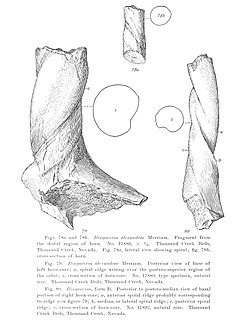 W
WCapromeryx was a genus of dwarf pronghorns (Antilocapridae) that originated in North America during the Pliocene about 5 million years ago. The closest living relative and only surviving member of the family is the North American pronghorn. Capromeryx furcifer is one of the smallest artiodactlys known, being 24 inches (61 cm) at the shoulder and 25 pounds (11 kg) in weight.
 W
WCapromeryx minor, sometimes known as the dwarf pronghorn, is a very small, extinct species of pronghorn-like antilocaprid ungulate discovered in the La Brea Tar Pits of California and elsewhere. It has been found at least as far east as the coast of Texas. It stood about 60 centimetres tall at the shoulders and weighed about 10 kilograms (22 lb). It is unclear whether females had horns as well as males. Each horn consists of a pair of short, straight points that sprout from a single base on either side of the head, with the two prongs parallel rather than diverging as in Tetrameryx and Stockoceros. A number of different species have been described which are likely all the same: Capromeryx furcifer, Capromeryx mexicana and Capromeryx minimus. Capromeryx furcifer would have priority as the proper name for the Late Irvingtonian through Rancholabrean species in which the anterior prong is less than 50% the height of the posterior prong. Its fossils have also been found at least as far east at as the Texas coast, as well as in Nebraska, Kansas, New Mexico, Sonora, Baja California, and near Mexico City. Specimens of this species date to the Late Irvingtonian and Rancholabrean periods. Two earlier species are known: Capromeryx tautonensis from Washington state and from Central Mexico in the Early Blancan, and Capromeryx arizonensis from the Late Blancan in Arizona, New Mexico and Florida. These two earlier species were larger and heavier than the Pleistocene species. It is thought by some biologists that it lived in forests and underbrush, where its small size would have helped it to hide. It is unlikely that it lived in open prairies, since it would not have been fast enough to outrun the predators of that time.
 W
WCosoryx is an extinct genus of antilocaprid that lived in the Miocene of Nevada. Fossils of this genus have also been found in the Santa Fe Group in New Mexico.
 W
WHayoceros is an extinct genus of the artiodactyl family Antilocapridae, endemic to North America during the Pleistocene epoch, existing for about 1.5 million years.
 W
WIlingoceros is an extinct genus of pronghorn artiodactyl from the Late Miocene of North America.
 W
WMerriamoceros is an extinct genus of pronghorn. It is known from a single species, which is also the type species, M. coronatus.
 W
WMerycondontinae is a subfamily of pronghorn that arose during the middle of the Miocene and became extinct by the end of that period.
 W
WMerycodus is an extinct genus of the artiodactyl family Antilocapridae. Fossils of this genus have been found in the Santa Fe Group of New Mexico.
 W
WOsbornoceros is an extinct artiodactyl genus of the family Antilocapridae. All antilocaprid species are extinct except for the pronghorn. Osbornoceros osborni is the only known species of the genus Osbornoceros. Osbornoceros lived during the Late Miocene around 7 to 6 million years ago in what is now North America. It is well represented in fossil discoveries, with nearly a dozen specimens having been found to date. All come from the Chamita Formation in a quarry near Lyden, New Mexico, the site of numerous other finds such as that of Chamitataxus, a prehistoric badger that lived at the same time. The holotype specimen of Osbornoceros was discovered in 1937 and many more were found nearby during further expeditions.
 W
WRamoceros is an extinct genus of the artiodactyl family Antilocapridae endemic to Middle Miocene (Clarendonian) North America.
 W
WStockoceros is an extinct genus of the North American artiodactyl family Antilocapridae, known from Mexico and the southwestern United States. Its horns are each divided near their base into two prongs of roughly equal length.
 W
WTetrameryx is an extinct genus of the North American artiodactyl family Antilocapridae, known from Mexico, the western United States, and Saskatchewan. The name means "four [horned] ruminant", referring to the division of each horn near its base into two prongs; in T. shuleri, the rear prong is much longer.